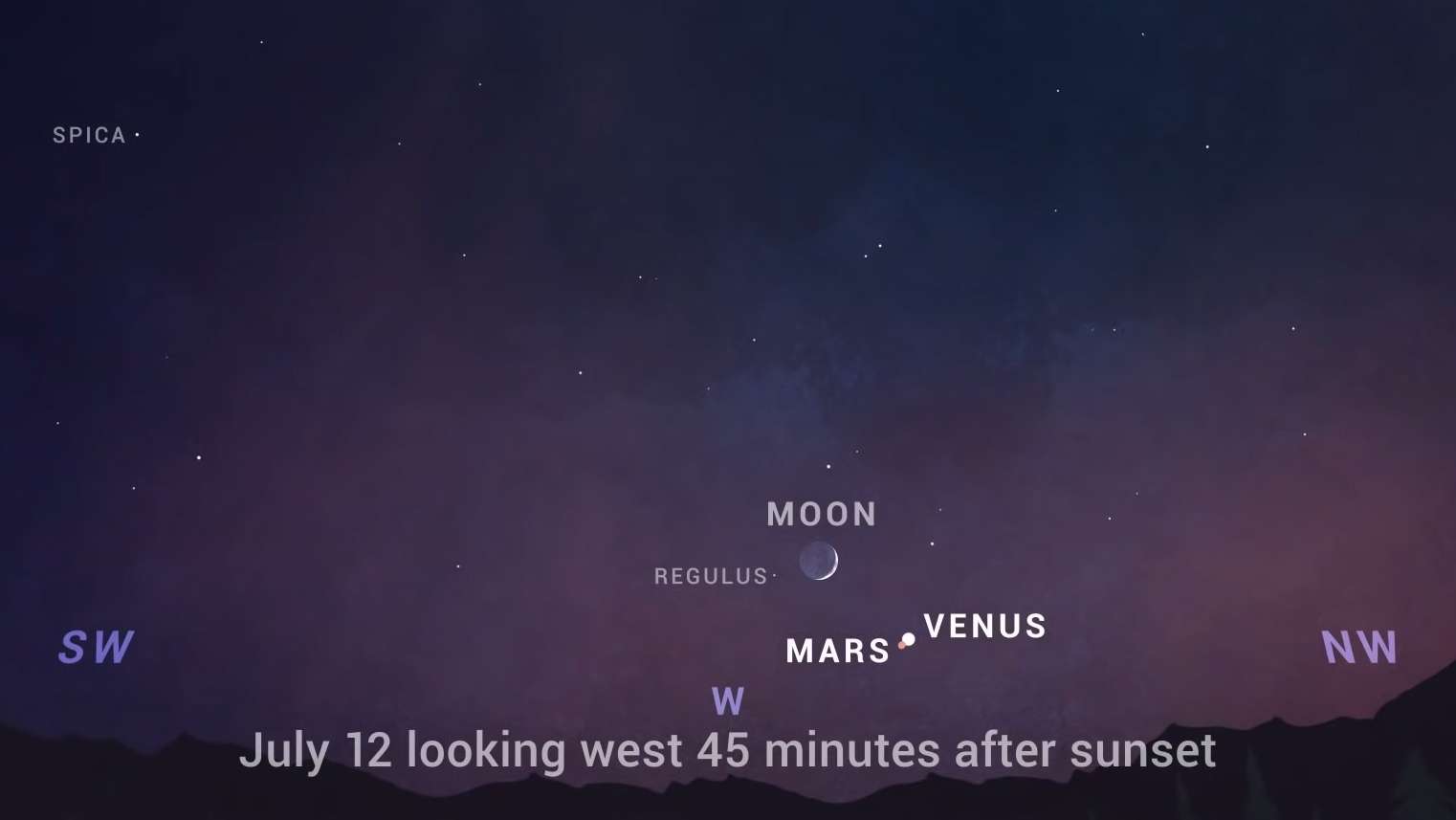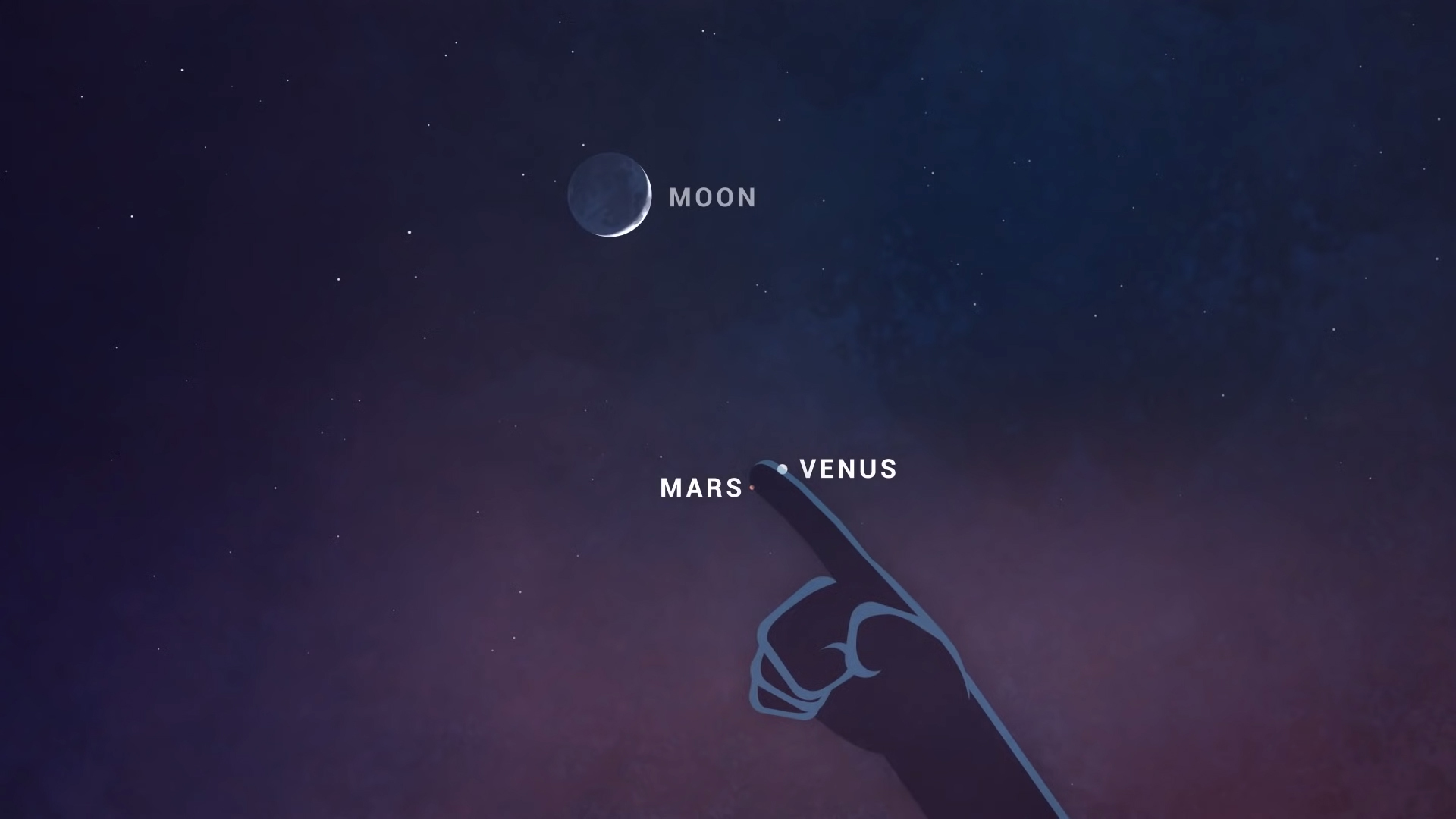Venus and the moon pass a fading Mars in the evening sky this weekend
Catch the trio above the western horizon about 45 minutes after sunset.

If there were ever a "maverick" among the naked eye planets, that title would certainly go to Mars.
Just nine months ago, Mars came to within 38.8 million miles (62.43 million kilometers) of Earth, the closest it had been to us since August 2003, and it will not be that close again until September 2035. Mars appeared three times brighter than Sirius, the brightest star in our sky and even rivaled Jupiter in brilliance. In fact, Mars ranked as the third brightest nighttime object behind the moon and Venus.
But that was then, this is now.
Related: The brightest planets in July's night sky: How to see them (and when)
Venus points the way
At this moment in time, Mars is on the other side of the brightness spectrum. On Sunday evening (July 11) look low in the west-northwest sky about 45 minutes after sunset.
You'll be able to use a very conspicuous benchmark in order to make a positive identification, for the first object to attract your attention will certainly be dazzling Venus. After you've found it, look about one degree to its immediate left and you'll see Mars appearing as a yellowish-orange, though by no means outstandingly bright star.

Don't expect the eye-popping object that adorned our skies in the early fall of 2020. Rather, right now Mars is much farther away from us at a distance of 231 million miles (371 million km). So, Mars will appear only about 1.7% as bright as it was nine months ago and a mere 0.5% as bright as Venus.
Get the Space.com Newsletter
Breaking space news, the latest updates on rocket launches, skywatching events and more!
In fact, by virtue of it currently shining at magnitude +1.8, Mars has dropped in rank to the category of a second-magnitude object; to assure you make a positive sighting I would strongly recommend you use binoculars.
The moon floats nearby
Another object appearing in the general vicinity of the two planets in the fading evening twilight will be the moon. Two days past new phase, it will appear as a hairline arc of light, just 4% illuminated and will be situated about a half-dozen degrees to the right of the two planets. If your clenched fist measures about 10 degrees at arm's length, then the moon and the two planets will be separated by roughly half a fist.

All three objects will remain in the west-northwest sky for about 90 minutes after sunset. Mars in fact is practically midway between two other noteworthy sky objects. At 45 minutes after sunset, the sky might still be too bright to see the moon and Mars readily with the naked eye, so already noted, you'll probably need binoculars. But after another 15 minutes have passed the sky will have darkened sufficiently so that you should readily be able to identify them with your unaided eyes, though they'll all be lower in the sky.
The scene will have changed noticeably the very next evening.
July 12 and beyond
On Monday, July 12, the moon will have widened a bit to 9% illuminated and will have shifted to a spot nearly 7 degrees to the upper left of the two planets. But the positions of the planets have also changed; the distance between them will have been halved with Venus now sitting just about a half degree to the right of Mars.
Venus will continue to grow more prominent — albeit rather slowly — in the western evening sky through the balance of 2021.
As for Mars, it will continue to be evident as an evening object for another couple of weeks or so, closely passing the bright bluish 1st-magnitude star, Regulus on July 29. But as we move into August, it will become lost in the bright sunset glow and will then go on a hiatus of sorts as it transitions into the morning sky, eventually reappearing in the early morning sky around Thanksgiving to set the stage for its gradual return to prominence during 2022.
Joe Rao serves as an instructor and guest lecturer at New York's Hayden Planetarium. He writes about astronomy for Natural History magazine, the Farmers' Almanac and other publications. Follow us on Twitter @Spacedotcom and on Facebook.
Join our Space Forums to keep talking space on the latest missions, night sky and more! And if you have a news tip, correction or comment, let us know at: community@space.com.

Joe Rao is Space.com's skywatching columnist, as well as a veteran meteorologist and eclipse chaser who also serves as an instructor and guest lecturer at New York's Hayden Planetarium. He writes about astronomy for Natural History magazine, Sky & Telescope and other publications. Joe is an 8-time Emmy-nominated meteorologist who served the Putnam Valley region of New York for over 21 years. You can find him on Twitter and YouTube tracking lunar and solar eclipses, meteor showers and more. To find out Joe's latest project, visit him on Twitter.









